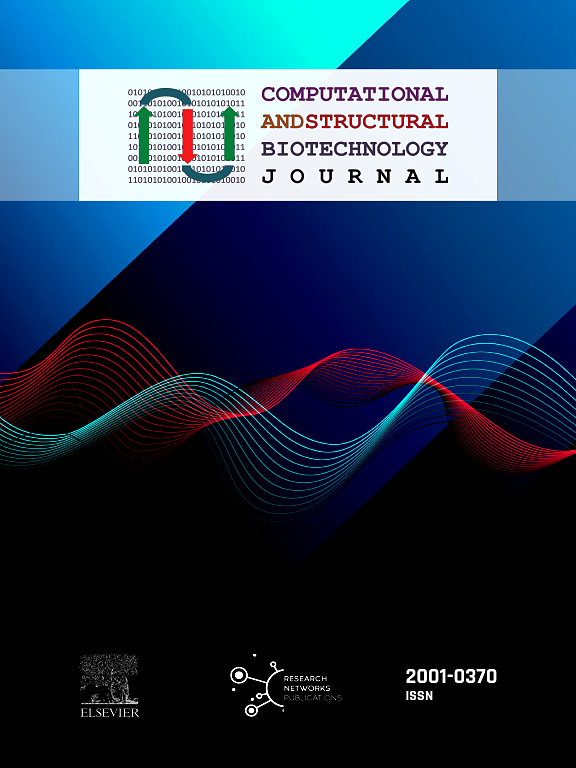Deciphering the cellular and molecular landscapes of Wnt/β-catenin signaling in mouse embryonic kidney development
IF 4.4
2区 生物学
Q2 BIOCHEMISTRY & MOLECULAR BIOLOGY
Computational and structural biotechnology journal
Pub Date : 2024-09-02
DOI:10.1016/j.csbj.2024.08.025
引用次数: 0
Abstract
The Wnt/β-catenin signaling pathway is critical in kidney development, yet its specific effects on gene expression in different embryonic kidney cell types are not fully understood. Wnt/β-catenin signaling was activated in mouse E12.5 kidneys using CHIR99021, with RNA sequencing performed afterward, and the results were compared to DMSO controls (dataset GSE131240). Differential gene expression in ureteric buds and cap mesenchyme following pathway activation (datasets GSE20325 and GSE39583) was analyzed. Single-cell RNA-seq data from the Mouse Cell Atlas was used to link differentially expressed genes (DEGs) with kidney cell types. β-catenin ChIP-seq data (GSE39837) identified direct transcriptional targets. Activation of Wnt/β-catenin signaling led to 917 significant DEGs, including the upregulation of and and the downregulation of and . These DEGs were involved in kidney development and immune response. Single-cell analysis identified 787 DEGs across nineteen cell subtypes, with Macrophage_Apoe high cells showing the most pronounced enrichment of Wnt/β-catenin-activated genes. Gene expression profiles in ureteric buds and cap mesenchyme differed significantly upon β-catenin manipulation, with cap mesenchyme showing a unique set of DEGs. Analysis of β-catenin ChIP-seq data revealed 221 potential direct targets, including and . This study maps the complex gene expression driven by Wnt/β-catenin signaling in embryonic kidney cell types. The identified DEGs and β-catenin targets elucidate the molecular details of kidney development and the pathway's role in immune processes, providing a foundation for further research into Wnt/β-catenin signaling in kidney development and disease.解密小鼠胚胎肾脏发育过程中 Wnt/β-catenin 信号传导的细胞和分子图谱
Wnt/β-catenin信号通路在肾脏发育过程中至关重要,但它对不同胚胎肾细胞类型中基因表达的具体影响还不完全清楚。研究人员使用 CHIR99021 激活了小鼠 E12.5 肾脏中的 Wnt/β-catenin 信号通路,随后进行了 RNA 测序,并将结果与 DMSO 对照组进行了比较(数据集 GSE131240)。分析了途径激活后输尿管芽和肾盖间充质的基因表达差异(数据集 GSE20325 和 GSE39583)。小鼠细胞图谱(Mouse Cell Atlas)的单细胞RNA-seq数据用于将差异表达基因(DEGs)与肾细胞类型联系起来。β-catenin ChIP-seq 数据(GSE39837)确定了直接转录靶标。激活 Wnt/β-catenin 信号导致了 917 个重要的 DEGs,包括和 的上调以及和 的下调。这些 DEGs 参与了肾脏的发育和免疫反应。单细胞分析在19种细胞亚型中发现了787个DEGs,其中巨噬细胞_载脂蛋白高细胞显示出最明显的Wnt/β-catenin激活基因富集。输尿管芽和管帽间充质的基因表达谱在β-catenin操作后有显著差异,管帽间充质显示出一组独特的DEGs。对β-catenin ChIP-seq数据的分析发现了221个潜在的直接靶标,包括 和 。这项研究绘制了胚胎肾细胞类型中由 Wnt/β-catenin 信号驱动的复杂基因表达图谱。所发现的DEGs和β-catenin靶点阐明了肾脏发育的分子细节以及该通路在免疫过程中的作用,为进一步研究Wnt/β-catenin信号在肾脏发育和疾病中的作用奠定了基础。
本文章由计算机程序翻译,如有差异,请以英文原文为准。
求助全文
约1分钟内获得全文
求助全文
来源期刊

Computational and structural biotechnology journal
Biochemistry, Genetics and Molecular Biology-Biophysics
CiteScore
9.30
自引率
3.30%
发文量
540
审稿时长
6 weeks
期刊介绍:
Computational and Structural Biotechnology Journal (CSBJ) is an online gold open access journal publishing research articles and reviews after full peer review. All articles are published, without barriers to access, immediately upon acceptance. The journal places a strong emphasis on functional and mechanistic understanding of how molecular components in a biological process work together through the application of computational methods. Structural data may provide such insights, but they are not a pre-requisite for publication in the journal. Specific areas of interest include, but are not limited to:
Structure and function of proteins, nucleic acids and other macromolecules
Structure and function of multi-component complexes
Protein folding, processing and degradation
Enzymology
Computational and structural studies of plant systems
Microbial Informatics
Genomics
Proteomics
Metabolomics
Algorithms and Hypothesis in Bioinformatics
Mathematical and Theoretical Biology
Computational Chemistry and Drug Discovery
Microscopy and Molecular Imaging
Nanotechnology
Systems and Synthetic Biology
 求助内容:
求助内容: 应助结果提醒方式:
应助结果提醒方式:


